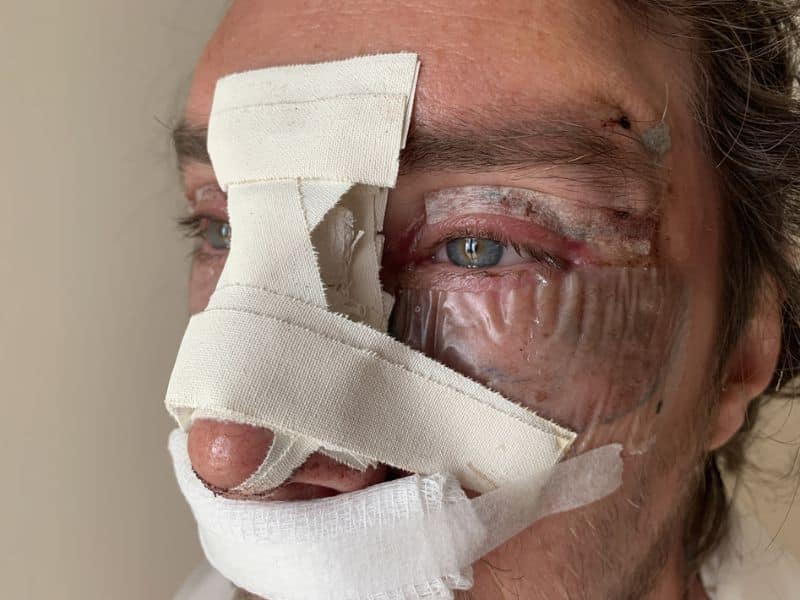Deep Plane Facelift Recovery Day by Day: What to Expect

A deep plane facelift can completely transform your face while retaining your natural glow and promoting a more youthful look. The entire goal of facelift surgery is to keep you looking natural and like yourself — but younger, fresher, and more revitalized.
If you’re on the books for a deep plane facelift surgery, you’re already getting prepared for your new look. But perhaps you also need to spend some time focusing on recovery.
So, below, let’s have a deep dive into what you can expect from your deep plane facelift recovery day by day. Of course, before we do this it might also be a good time to briefly answer the question: What is deep plane facelift surgery?
Table of Contents
ToggleDeep Plane Facelift Overview
A deep plane facelift is a plastic surgery procedure that reduces visible signs of aging on the face, especially in more mature men and women. If you have deep folds, jowls (sagging skin along the jawline), drooping cheeks, bags beneath your eyes, and excess skin on your neck, you may be a great candidate for a deep plane facelift.
Unlike traditional facelift surgery, a deep plane facelift treats the outer (skin) layer of your face and the SMAS (superficial musculoaponeurotic system) layer as one unit. These layers and deeper tissues are lifted up, and the underlying tissue of the face are manipulated so that your face looks younger and fresher (while still being natural) when healed.
One other key factor that differentiates a deep plane facelift from other types of facelift surgery is the fact that your plastic surgeon will be releasing the ligaments beneath the SMAS layer. These facial ligaments typically keep your skin in place so that it doesn’t shift too much. But when they are released, you get a lot of great mobility in the face, and your surgeon will then be able to gently and naturally improve tightness, smooth lines and wrinkles, and correct sagging skin.
Deep Plane Facelift Recovery Day by Day: Facelift Scar Healing Timeline
Every patient’s surgical journey and facelift recovery timeline will be unique. As always, it’s essential to follow your surgeon’s personalized advice. Attend all follow-up appointments during the healing process. Diligent care will help ensure the best possible outcome.
Day 1: Immediately After Surgery
Right after your cosmetic surgery, you will be under the care of your surgical team until you wake up from anesthesia. You will be in a recovery room where you can rest for a time before being discharged. Have someone there to take you home.
Small drains may be placed to prevent the buildup of fluid. These will be removed within a day or two. In addition, know that your face will be wrapped in bandages to minimize swelling and support your new contours.
Some discomfort, initial swelling, and bruising are normal. Take it easy and rest a lot. Do not lift anything heavy or do strenuous exercise. If pain persists, use your prescribed pain medication. It’s normal to experience tightness and changes in sensation.
Days 2-3
Continue focusing on rest to speed up the healing process. During your initial recovery period, you’ll have more swelling and bruising, which will peak around day three. Keeping your head elevated can help reduce swelling. If you are still uncomfortable, take pain relievers and any prescribed antibiotics.
In addition, be sure to follow your surgeon’s instructions for caring for your incisions. You’ll need to keep the area clean and dry. You should also protect yourself from harsh sun exposure.
Finally, do not lift, bend, or exercise. You should do some light walking, but that’s it. Eat a healthy protein-rich diet.
Days 4-7
As you progress through the first week, you’ll notice gradual improvements. Swelling, bruising and visible scarring will continue, but still keep your head elevated. Most patients can stop taking prescription pain medications now, though over-the-counter options may be used. Maintain a healthy balanced diet to support the healing process. Also, avoid scratching the incision because it can delay healing.
By the end of the first week, your 1-week post-op deep plane facelift scars should be forming. In other words, your incisions should be healing nicely together, and the incision sites should be scarring over.
Week 2
After 2 weeks post-surgery, you should start feeling more like yourself, though you will still need to take it easy. Bruising and swelling will be down, and you should feel that you look a bit more like yourself.
Continue to follow your surgeon’s care instructions. Many patients can return to work now.
Weeks 3-4
As you enter the next few weeks, you’ll notice significant improvements in your appearance and comfort level. At this point, many patients are able to go back to some very light exercise and many of their normal activities. Continue to follow your surgeon’s instructions.
Week 5 and Beyond
Over the next facelift recovery week, your final results will become more evident as residual swelling continues to subside. Talk to your surgeon about when you can return to normal exercise and whether you should start scar management (silicone gel sheets, massage, etc.).
Continue to follow a healthy lifestyle and skincare regimen throughout your recovery period to maintain your new facial skin and youthful appearance. Proper skincare will soften deep plane facelift scars to blend with your natural skin tone.
6 to 12 Months After Surgery
This is the most awaited moment. Your patience now pays off as you see your full results after 6 months of your surgical procedure. Most patients report looking 10 to 15 years younger. With a healthy lifestyle, deep-plane facelift results can last up to a decade or more.
Deep Plane Facelift Day by Day Recovery FAQs
How much is a deep plane facelift?
Any surgical procedure performed by an experienced board-certified plastic surgeon is going to be a significant investment. However, deep plane facelift costs can vary drastically depending on where you get your cosmetic surgery, who you choose as your surgeon and the entire scope of your procedure.
Call us today to book a consultation where you can learn more about what goes into forming an estimate for this procedure.
How long will my face be numb after a deep plane facelift surgery?
If you experience tingling, numbness, or other changes in sensation during the recovery process following a deep plane facelift procedure, this is normal. Often, the blood flow changes in the face after your surgical procedure, cold compresses can affect sensation in the face (as can lingering swelling), and during the procedure, your facial nerves may be slightly bothered.
Most of the time, this only goes on for a few days, weeks, or at most, months. Talk to your surgeon if it persists.
Where are the scars on a deep plane facelift?
Your surgeon will carefully place the incisions to keep them as hidden as possible. They’re usually around the ear and along the hairline behind it.
What is the downside of a deep plane facelift?
While a deep plane facelift delivers long-lasting and natural results, it has certain disadvantages. The downside of a deep plane facelift is that it has a longer recovery time and a higher risk of complications (nerve damage, uneven results). It is also more expensive than the traditional facelift.
What mental and physical preparation should I expect for my deep plane facelift recovery journey?
Understanding that this is major surgery helps set realistic expectations for your recovery timeline. Whether you’re having a deep plane facelift or neck lift, maintaining a positive mental attitude throughout the healing process is crucial for the best outcome.
Following your post-surgery care instructions will guide you through the typical healing process from early swelling to natural-looking results. Having strong support from family and friends is essential, as recovery can be difficult at first.
All my patients are reminded that patience is key – as residual swelling subsides over several months, you’ll notice a significant difference in your final appearance compared to the immediate post-surgical period.
What dietary and emotional considerations should I be aware of during my recovery period?
Your recovery involves both physical and emotional healing, which requires careful attention to nutrition and mental well-being. In the early days post surgery, focus on soft foods that are easy to chew and swallow, as this supports healing and prevents strain on facial muscles. Light walking encourages blood flow and helps prevent complications, though patients return to normal activities gradually over two weeks.
Many patients feel anxious about their appearance during the initial healing phase, so having emotional support from family and friends is crucial. Your surgeon will review your medical history to ensure optimal healing conditions, and while you may notice some initial results immediately, remember that the final outcome develops as swelling subsides. Patients begin to feel more confident about their appearance as the healing progresses and they can better assess their transformation.
Book a Consultation for Deep Plane Face lift Surgery
Ready to take the next step toward a deep plane face lift Las Vegas? Board-certified plastic surgeon Dr. Rachel Mason performs deep plane lifts for her facelift patients in Las Vegas.
Patients report a significant reduction in wrinkles, fine lines, sagging, jowls, and other signs of aging after their smooth and successful recovery process. Contact us today to learn more about this cosmetic surgical procedure and find out if you’re a good candidate.


